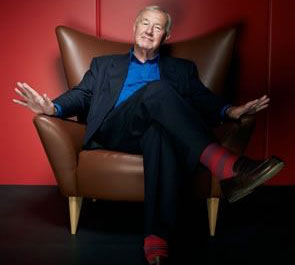 英国著名设计师、零售商、餐厅所有人特伦斯•康兰,在过去的50年里,深远地影响了英国人的生活方式和饮食习惯。自1964年开始,他创立的Habitat家具设计连锁店便以适宜的价格为客户提供简约和设计良好的各种家饰品。几十年过后,他的餐厅在带领英国走向精致、独特的餐饮时代方面功不可没。
英国著名设计师、零售商、餐厅所有人特伦斯•康兰,在过去的50年里,深远地影响了英国人的生活方式和饮食习惯。自1964年开始,他创立的Habitat家具设计连锁店便以适宜的价格为客户提供简约和设计良好的各种家饰品。几十年过后,他的餐厅在带领英国走向精致、独特的餐饮时代方面功不可没。
特伦斯先生的日程总是安排得很满。目前他正忙于伦敦设计博物馆的工作。这个博物馆的存在跟特伦斯先生1982年创立其“前身”有关系——这个前身其实就是一个锅炉房(the Boilerhouse),确切地说是维多利亚与艾伯特博物馆(Victoria and Albert Museum)的一个废弃的地下室,但它的成功造就了1989年伦敦设计博物馆时代的开启,现在的伦敦设计博物馆位于泰晤士。过去的30年,康兰基金会帮该博物馆已经升值到5000万英镑。
您为何会有在英国创办一个设计博物馆这种强烈的想法?
早年作为一名设计师的时候,我就一直被米兰国际家具展深深吸引。我亲身体会了观赏世界最具现代化设计的展品带来的影响,无论是学生还是制造商,都足以令其兴奋和深受启发。于是,我开始幻想,英国怎样才能拥有这样的展会——所以,在我谨慎投资创办Habitat的同时,我也创办了康兰基金会,其初衷就是希望在英国为现代设计展创建一个永远的家。
不同于现在的许多年轻设计师,您已经尝试亲手制造了好多东西,从砌砖、陶瓷到焊接。您认为那样对你的设计师生涯很重要吗?
当然——我的工作内容经常包括产品制造的过程,我永远不会为自己不懂怎么制作的东西做设计。记得当我还是小男孩的时候,我最喜欢的礼物是一包木屑和一个可爱的工具箱,经过几番纠缠,母亲终于同意给我一块地方作工作间,也允许我建一个烧木材的陶窑。毫无疑问,就是在那儿,我第一次对成为一名设计师产生了好奇心。我认为,对任何设计师而言,捋起袖子、高度投入到制造过程当中是至关重要的,因为这种投入会让你对设计本身以及它是如何联系客户的,有更深层次的理解。
您是否认为所有设计师都应该学习不依靠电脑、亲自用手制造产品吗?
当我们必须依靠电脑时,一定要避免成为电脑的奴隶——最好的创意往往从一支HB铅笔和一张白纸开始。
您是英国平装家具制造的教父级人物,引进了意大利咖啡机这样的新式器皿,是什么原因让您有如此强烈的想改变人们生活方式的意愿?
这些意愿缘于我们这代人的挫败感。战后的英国,所有东西看上去都是那么灰暗,这种景象让人无法遗忘。但是,年轻的一代人逐渐成长起来,第一次地,他们口袋里也有了一些钱,于是,他们想过一种不同于自己父母的生活。“摇摆60年代”的种子其实在十年前已经种下了。20年后康兰餐馆的创立也是同样的故事——伦敦人口袋里有很多钱,于是想享受在外面享用美食的快乐,但现实中周围却没有好餐馆。事实上,这个选择有些匪夷所思,伦敦现在是世界上最适合在外用餐的城市,这相当难以置信。人们只能买餐馆提供的食品,这也是人们味蕾继续变化的根本原因。
Habitat的菜单也都非常独特,就像用优质有光纸印刷的杂志。
与店面装饰一样,菜单也仅仅是一个充满惊喜的新橱窗,通过它,我们可以展示产品,也让顾客大开眼界,原来他们可以这么在家里吃,达到激励顾客的目的。1965年,我们第一次使用的菜单采用的是活页纸,最后这种菜单增加到88页,而且是全彩的。这种菜单由公司的一个专门部门在管理,该部门的全部责任就是保证它的生产。
您曾说生活在一个不制造损害国家自尊心的产品的国家。您说这句话是什么意思?
我的毕生信念是:我们能够拥有这个国家最了不起的工匠。如果再延伸到这样一个事实——英国的创意产业是世界上最好的,那么为什么我们不再是世界上上以制造业为荣的国家呢?我们要保证一直使用和重视这些工艺,因为这些是我们的过去中非常重要的一部分,我们必须想办法让它也成为我们未来的一部分。生活中没有什么事情比失业更让人沮丧的了,创造工作最简单的方法就是雇人制造产品。对我来说这一点简单得甚至有些离谱。政府应该懂得艺术、设计、工艺和最终的制造所扮演的重要角色。它们为经济做出了很大贡献,而回报却仅仅是很小的一部分基金。
A DESIGNER, restaurateur and retailer, Sir Terence Conran has significantly influenced the way we live and eat in Britain over the past five decades. Beginning in 1964, his Habitat chain of stores helped to introduce simple, well-designed housewares at affordable prices. Decades later, his restaurants did much to introduce the country to fine and stylish cuisine.
Sir Terence remains busy. A new retrospective of his work is also now on at London’s Design Museum. That this museum even exists is in part due to Sir Terence’s work in establishing its forerunner, called the Boilerhouse, in the basement of the Victoria and Albert Museum in 1982. The project’s success led to the opening of the Design Museum in 1989 at its current spot in Shad Thames. Over the past 30 years the Conran Foundation has supported the museum to the tune of £50m.
Why did you feel strongly about creating a design museum in London?
I’d always been fascinated by Milan’s Triennale in my early years as a designer. I saw how stimulating and influential it was for both students and manufacturers to see the design of the best contemporary products in the world. I started to dream about how something similar could happen in the UK—so when I made serious money through the flotation of Habitat I set up the Conran Foundation with the idea of creating a permanent home in the UK for the display of modern design.
Unlike many young designers today you learned how to make many things with your hands, from brick-laying and pottery to welding. Do you think that was important for your career as a designer?
Absolutely—I have always related my work to the manufacturing process and never designed anything I wouldn’t know how to make myself. As a small child I remember my favourite present was a bag of wooden off cuts and a pretty basic tool kit. After much pestering, my mother gave me a space for a small workshop and allowed me to set up a wood fired pottery kiln. There is no doubt it is where I first began to develop the curious mind of a designer. I think it is vital for any designer to roll their sleeves up and get heavily involved in the making process because it helps you get a deeper level of understanding about design and how it relates to the consumer.
Do you think all designers should learn to 'make' things without using a computer?
While we must embrace computers, we must not become slaves to them—the best ideas always start with an HB pencil and a sheet of plain paper.
You were the first person to make flat-pack furniture in Britain, and you introduced new cooking utensils such as Italian coffee-makers to this country. Why do you think you had such a desire to change people's lifestyles?
It grew out of our generation’s sense of frustration.What you have to remember is how grim things were in postwar Britain. But there was a younger generation growing up who, for the first time, had a bit of money in their pockets and wanted to live a different life to that of their parents. The seeds of the “swinging sixties” were actually sewn a decade earlier. Over two decades later when we were establishing Conran restaurants it was a similar story—Londoners were flush with money and wanted to enjoy the pleasure of eating out, but there were practically no good restaurants around. In fact the choice was appalling, which is incredible to think as London is now the best city in the world to eat out. People can only buy what they are offered, and that is fundamentally how people’s taste evolves.
The Habitat catalogues were also quite unique. They were like glossy magazines.
Along with the shopfronts, the catalogues were just a new and exciting way of showcasing our products and opening people’s eyes to how they may look in their own home. We wanted to inspire people. We started them in 1965 as loose sheets attached in one corner, and eventually the catalogue grew to 88 pages in full colour, managed by a specialist department within the company dedicated entirely to its production.
I have heard you say that living in a country that doesn't make things destroys national pride. What do you mean?
My lifelong belief is that we have the most amazing craftsmen in this country. If you add this to the fact the UK’s creative industries are the finest in the world, then why on earth are we no longer a country that prides itself on making things? We need to ensure we keep utilising and valuing these skills. They were a vital part of our past and we must find a way to make them part of our future. There is nothing more profoundly depressing in life than unemployment, and the easiest way to create jobs is to employ people to make things. It seems so absurdly simple to me. The government needs to understand the vital role of the arts, design, craft and ultimately manufacturing. They give back so much more to the economy in return for a relatively small amount of funding.
 英国著名设计师、零售商、餐厅所有人特伦斯•康兰,在过去的50年里,深远地影响了英国人的生活方式和饮食习惯。自1964年开始,他创立的Habitat家具设计连锁店便以适宜的价格为客户提供简约和设计良好的各种家饰品。几十年过后,他的餐厅在带领英国走向精致、独特的餐饮时代方面功不可没。
英国著名设计师、零售商、餐厅所有人特伦斯•康兰,在过去的50年里,深远地影响了英国人的生活方式和饮食习惯。自1964年开始,他创立的Habitat家具设计连锁店便以适宜的价格为客户提供简约和设计良好的各种家饰品。几十年过后,他的餐厅在带领英国走向精致、独特的餐饮时代方面功不可没。
